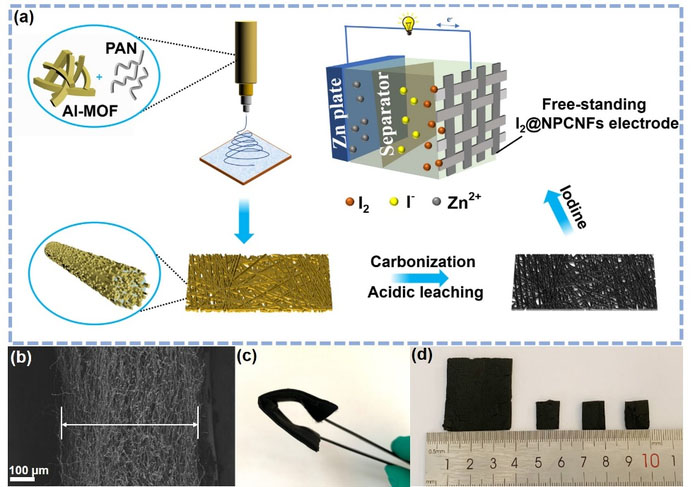| Mar 16, 2022 |
Shapeable carbon fiber networks with hierarchical porous structure for high-performance Zn-I2 batteries
(Nanowerk News) Recently, iodine is increasingly clubbed with zinc anodes to fabricate sustainable zinc–iodine (Zn–I2) batteries (ZIBs) due to its high redox potential (I2/I-, 0.62 V vs. standard hydrogen electrode) and large theoretical capacity (211 mAh g-1). More importantly, the conversion reaction of iodine with high energy efficiency on a cathodic chamber endows ZIBs with distinguishable advantages over metal–ion batteries.
|
|
Unfortunately, ZIBs batteries suffer from the insulating iodine, low utilization ratio of active source, and the shuttle effect, resulting in the fast capacity decay and undesirable self-discharging issues.
|
|
Various forms of porous carbons to confine iodine and elevate electrochemical kinetics have been fabricated. Recently, metal-organic framework (MOF) has been regarded as a promising precursor to fabricate heteroatoms-doped porous carbon materials due to their large surface area, controllable pore size and adjustable structures. To further enable advanced energy storage and extend the lifetime of batteries, rational design of a flexible, self-supported and binder-free cathode is very essential for ZIBs.
|
 |
| (a) Schematic illustration for the synthesis process of I2@NPCNFs-800 to fabricate zinc-iodine battery. (b) Cross-section SEM image of NPCNFs-800. (c,d) Photographs of flexible and freestanding NPCNFs-800 electrode. (© Science China Press)
|
|
Electrospinning is a facile and versatile technology to produce a free-standing three dimensional interconnected network. Therefore, the combination of the inherent advantages of the MOF and the unique characteristics of electrospinning is feasible to fabricate flexible fibrous membranes for enhancing reversible iodine accommodation.
|
|
Very recently, Dr. Jin-Tao Zhang group reported a facile method for the production of self-supported N-doped porous carbon nanofibers (NPCNFs) via a controlled thermal treatment of Al–MOF/ PAN composite fibers prepared with the electrospinning method (Science China Chemistry, "Shapeable carbon fiber networks with hierarchical porous structure for high-performance Zn–I2 batteries").
|
|
PAN bridging among the Al–MOF nanorods is efficient to obtain the integrated carbon fibers for synthesizing the hierarchically porous carbon network. Benefiting from the unique porous structure and nitrogen doping, the as-prepared NPCNFs can serve as a conductive support to firmly trap iodine and effectively inhibit its dissolution. When evaluated as cathode materials for ZIBs, the I2@NPCNFs-800 exhibited impressive long-time cycling durability of 6,000 cycles. The in-situ Raman spectroscopy revealed that NPCNFs provided the comparatively stable electrochemical environment for reversible redox conversion.
|
|
Prior to fabricate the nanofibers, highly dispersed and uniform Al-MOF rod-like were prepared. Then, the Al-MOF/PAN fibers were prepared via the electrospinning method with the precursor solution consisting of N, N-dimethylformamide (DMF), Al-MOF, and polyacrylonitrile (PAN).
|
|
The thermal treatment at 800 °C in N2 and subsequent acidic leaching led to the formation of free-standing and flexible porous carbon nanofibers with nitrogen doping (namely NPCNFs-800). Then, iodine was loaded via melt-diffusion method and the obtained composite without additional additives was named as I2@NPCNFs-800.
|
|
The I2@NPCNFs-800 film can be directly tested as a free-standing electrode to fabricate Zn-iodine batteries (ZIBs) for achieving good cycling life and high reversible capacity.
|
|
The researchers explored the different calcination temperatures of the materials (700-900 °C) on the performance of zinc-iodine battery. Among them, the carbon nanofiber membrane calcined at 800 °C exhibited stronger adsorption and shuttle inhibition of iodine, which showed the best rate capability, self-discharge and cyclic stability. In addition, the composition, pore size and reaction kinetics of various samples calcined at different temperatures were analyzed to explain the differences in their electrochemical performance.
|
|
Finally, the energy storage mechanism of zinc-iodine battery was revealed by in-situ Raman spectroscopy. The results obviously exhibited the reversible transformation: I5-↔I3-↔I-.
|
|
Additionally, the I 3d XPS spectra was conducted to identify the valence state of iodine species during charge/discharge process, which also demonstrated a highly reversible process and efficient two-step conversion reaction mechanism for our ZIBs.
|

